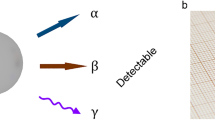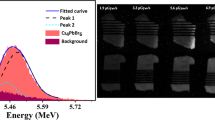Abstract
The decay of the majority of radioactive isotopes involves the emission of gamma (γ) photons with energies of ∼50 keV to 10 MeV. Detectors of such hard radiation that are low-cost, highly sensitive and operate at ambient temperatures are desired for numerous applications in defence and medicine, as well as in research1,2. We demonstrate that 0.3–1 cm solution-grown single crystals (SCs) of semiconducting hybrid lead halide perovskites (MAPbI3, FAPbI3 and I-treated MAPbBr3, where MA = methylammonium and FA = formamidinium) can serve as solid-state gamma-detecting materials. This possibility arises from a high charge-carrier mobility–lifetime (μτ) product of 1.0–1.8 × 10−2 cm2 V−1, a low dark carrier density of 109–1011cm−3 (refs 3,4), a low density of charge traps of 109–1010 cm−3 (refs 4,5) and a high absorptivity of hard radiation by the lead and iodine atoms. We demonstrate the utility of perovskite detectors for testing the radiopurity of medical radiotracer compounds such as 18F-fallypride. Energy-resolved sensing at room temperature is presented using FAPbI3 SCs and an 241Am source.
This is a preview of subscription content, access via your institution
Access options
Subscribe to this journal
Receive 12 print issues and online access
$209.00 per year
only $17.42 per issue
Buy this article
- Purchase on Springer Link
- Instant access to full article PDF
Prices may be subject to local taxes which are calculated during checkout




Similar content being viewed by others
Change history
03 August 2016
In the version of this Letter originally published online, in the sentence beginning 'A combined benefit of the reduced defect density...', ref. 21, instead of ref. 18, should have been cited. This has now been corrected in all versions of the Letter.
References
Del Sordo, S. et al. Progress in the development of CdTe and CdZnTe semiconductor radiation detectors for astrophysical and medical applications. Sensors 9, 3491–3526 (2009).
Milbrath, B. D., Peurrung, A. J., Bliss, M. & Weber, W. J. Radiation detector materials: an overview. J. Mater. Res. 23, 2561–2581 (2008).
Shi, D. et al. Low trap-state density and long carrier diffusion in organolead trihalide perovskite single crystals. Science 347, 519–522 (2015).
Zhumekenov, A. A. et al. Formamidinium lead halide perovskite crystals with unprecedented long carrier dynamics and diffusion length. ACS Energy Lett. 32–37 (2016).
Dong, Q. et al. Electron-hole diffusion lengths >175 μm in solution-grown CH3NH3PbI3 single crystals. Science 347, 967–970 (2015).
McGregor, D. & Hermon, H. Room-temperature compound semiconductor radiation detectors. Nucl. Instrum. Meth. A 395, 101–124 (1997).
Androulakis, J. et al. Dimensional reduction: a design tool for new radiation detection materials. Adv. Mater. 23, 4163–4167 (2011).
Wang, P. L. et al. Hard radiation detection from the selenophosphate Pb2P2Se6 . Adv. Funct. Mater. 25, 4874–4881 (2015).
Stoumpos, C. C. et al. Crystal growth of the perovskite semiconductor CsPbBr3: a new material for high-energy radiation detection. Cryst. Growth Des. 13, 2722–2727 (2013).
Takahashi, T. & Watanabe, S. Recent progress in CdTe and CdZnTe detectors. IEEE Trans. Nucl. Sci. 48, 950–959 (2001).
Eisen, Y. & Shor, A. CdTe and CdZnTe materials for room-temperature X-ray and gamma ray detectors. J. Cryst. Growth 184, 1302–1312 (1998).
Mitzi, D. B. Progress in Inorganic Chemistry 1–121, Vol. 48 (ed. Karlin, K. D.) (John Wiley & Sons, 1999).
Park, N.-G. Perovskite solar cells: an emerging photovoltaic technology. Mater. Today 18, 65–72 (2015).
Lee, M. M., Teuscher, J., Miyasaka, T., Murakami, T. N. & Snaith, H. J. Efficient hybrid solar cells based on meso-superstructured organometal halide perovskites. Science 338, 643–647 (2012).
Gratzel, M. The light and shade of perovskite solar cells. Nature Mater. 13, 838–842 (2014).
Green, M. A., Ho-Baillie, A. & Snaith, H. J. The emergence of perovskite solar cells. Nature Photon. 8, 506–514 (2014).
Dou, L. et al. Solution-processed hybrid perovskite photodetectors with high detectivity. Nature Commun. 5, 5404 (2014).
Fang, Y., Dong, Q., Shao, Y., Yuan, Y. & Huang, J. Highly narrowband perovskite single-crystal photodetectors enabled by surface-charge recombination. Nature Photon. 9, 679–686 (2015).
Lin, Q., Armin, A., Burn, P. L. & Meredith, P. Filterless narrowband visible photodetectors. Nature Photon. 9, 687–694 (2015).
Yakunin, S. et al. Detection of X-ray photons by solution-processed lead halide perovskites. Nature Photon. 9, 444–449 (2015).
Wei, H. et al. Sensitive X-ray detectors made of methylammonium lead tribromide perovskite single crystals. Nature Photon. 10, 333–339 (2016).
Tan, Z.-K. et al. Bright light-emitting diodes based on organometal halide perovskite. Nature Nanotech. 9, 687–692 (2014).
Xing, G. et al. Low-temperature solution-processed wavelength-tunable perovskites for lasing. Nature Mater 13, 476–480 (2014).
Zhu, H. et al. Lead halide perovskite nanowire lasers with low lasing thresholds and high quality factors. Nature Mater. 14, 636–642 (2015).
Grodstein, G. W. X-ray Attenuation Coefficients from 10 keV to 100 MeV (US Department of Commerce, National Bureau of Standards, 1957).
Saidaminov, M. I. et al. High-quality bulk hybrid perovskite single crystals within minutes by inverse temperature crystallization. Nature Commun. 6, 7586 (2015).
Saidaminov, M. I., Abdelhady, A. L., Maculan, G. & Bakr, O. M. Retrograde solubility of formamidinium and methylammonium lead halide perovskites enabling rapid single crystal growth. Chem. Commun. 51, 17658–17661 (2015).
Street, R. A. et al. Comparison of PbI2 and HgI2 for direct detection active matrix x-ray image sensors. J. Appl. Phys. 91, 3345–3355 (2002).
Kabir, M. Z. & Kasap, S. O. Charge collection and absorption-limited sensitivity of x-ray photoconductors: applications to a-Se and HgI2 . Appl. Phys. Lett. 80, 1664–1666 (2002).
Kim, K. et al. Purification of CdZnTe by electromigration. J. Appl. Phys. 117, 145702 (2015).
Yang, T. Y., Gregori, G., Pellet, N., Grätzel, M. & Maier, J. The significance of ion conduction in a hybrid organic–inorganic lead-iodide-based perovskite photosensitizer. Angew. Chem. Int. Ed. 54, 7905–7910 (2015).
Ametamey, S. M., Honer, M. & Schubiger, P. A. Molecular imaging with PET. Chem. Rev. 108, 1501–1516 (2008).
Mukherjee, J., Yang, Z.-Y., Das, M. K. & Brown, T. Fluorinated benzamide neuroleptics—III. Development of (S)-N-[(1-allyl-2-pyrrolidinyl)methyl]-5-(3-[18F]fluoropropyl)-2,3-dimethoxybenzamide as an improved dopamine D-2 receptor tracer. Nucl. Med. Biol. 22, 283–296 (2010).
Snaith, H. J. et al. Anomalous hysteresis in perovskite solar cells. J. Phys. Chem. Lett. 5, 1511–1515 (2014).
Li, Z. et al. Stabilizing perovskite structures by tuning tolerance factor: formation of formamidinium and cesium lead iodide solid-state alloys. Chem. Mater. 28, 284–292 (2016).
Aharon, S., Dymshits, A., Rotem, A. & Etgar, L. Temperature dependence of hole conductor free formamidinium lead iodide perovskite based solar cells. J. Mater. Chem. A 3, 9171–9178 (2015).
Acknowledgements
M.V.K. acknowledges financial support from the European Union through the FP7 (ERC Starting Grant NANOSOLID, GA No. 306733). We are indebted to S. Ametamey, B. Mancosu and S. Boss of the Center for Radiopharmaceutical Sciences of ETH for providing access to the radiochemistry laboratory and technical assistance, M. Badertscher for providing radioactive sources, M. Wörle for assistance with X-ray sources, and N. Stadie for reading the manuscript.
Author information
Authors and Affiliations
Contributions
M.V.K. and S.Y. conceived and planned the work. S.Y., Y.S. and D.K. performed measurements of the response of perovskite SCs to γ and X-rays. S.Y. analysed the result. D.N.D., V.M., I.C. and O.N grew the perovskite SCs. T.N. provided technical advice for radiation experiments. M.V.K. supervised the work. S.Y. and M.V.K. wrote the manuscript. All authors discussed the results and commented on the manuscript.
Corresponding author
Ethics declarations
Competing interests
The authors declare no competing financial interests.
Supplementary information
Supplementary information
Supplementary information (PDF 1389 kb)
Rights and permissions
About this article
Cite this article
Yakunin, S., Dirin, D., Shynkarenko, Y. et al. Detection of gamma photons using solution-grown single crystals of hybrid lead halide perovskites. Nature Photon 10, 585–589 (2016). https://doi.org/10.1038/nphoton.2016.139
Received:
Accepted:
Published:
Issue Date:
DOI: https://doi.org/10.1038/nphoton.2016.139
This article is cited by
-
The effect of the PbI\(_2\) surface passivation on the leakage current for MAPbI\(_3\) single crystal nuclear detectors
Journal of Materials Science: Materials in Electronics (2024)
-
A double-tapered fibre array for pixel-dense gamma-ray imaging
Nature Photonics (2023)
-
High-yield growth of FACsPbBr3 single crystals with low defect density from mixed solvents for gamma-ray spectroscopy
Nature Photonics (2023)
-
Detector-grade perovskite single-crystal wafers via stress-free gel-confined solution growth targeting high-resolution ionizing radiation detection
Light: Science & Applications (2023)
-
Stable perovskite single-crystal X-ray imaging detectors with single-photon sensitivity
Nature Photonics (2023)



